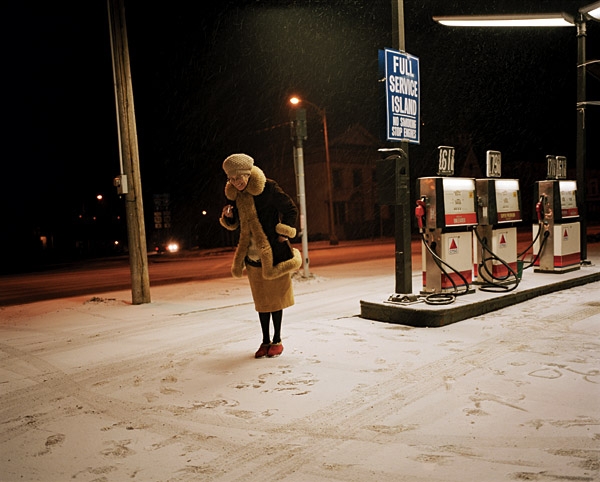Exhibition
Tierney Gearon's photographs have been called manipulative, disturbingly ambiguous, even perverse; the London police demanded that the Saatchi Gallery which first showed the offending photos of her young children take the pictures down. Tierney has always maintained she loves her subjects deeply and understands them better than anyone else. How could she not? They are her family.
Excerpt from the Forward to the Book
When I first saw the images from Daddy Where are you? I wanted to ask Tierney Gearon for every detail of this woman, her mother, who seemed to display so many faces -- dejected, exuberant, brave, lonely, or flamboyant ones -- in a matter of moments. Tierney explained, though, that her journey behind the lens was more relevant to the work than the details of her mother's illness.
"My mother had no boundaries,"Â she said in speaking of her childhood with her father and three younger brothers in Atlanta, Georgia. It was a hierarchy that threw her into a maternal role early on.
Now the mother of four children -- Emilee, Michael, Walker, and Grace -- Tierney wanted to resurrect parts of her own past, and in doing so she was able to discover her own growth process.
With her kids in tow, she chronicled visits to her mom in upstate New York, shooting spontaneously as events occurred, walking in fields, peering or placing herself in quotidian bedroom or bathroom scenes. As she went along, sometimes she would add an element to see what might take place -- asking her mom to put on a mask for example -- then shoot.
"When I started documenting times with my mother, it felt good to be able to express what I was feeling inside and translate it. I do not have the need to take photos twenty four hours a day. I select moments to switch into 'camera mode.' And when I look back on a lot of these images, I feel most of them are self-portraits of my soul. Being around my mother is such a painful and happy experience. I tried to take the best of my mom and apply it to the way I look at life. These are not photos of a woman who is ill, but of a relationship between a mother and a daughter -- two artists. This work is how I transfer my feeling into art to process pain and frustration. The last time I visited my mother, I remember her standing next to Walker, and I decided to give Walker the baby to see what would occur. And then I saw him holding Grace, shielding her as though he was guarding her from my mother. It's interesting -- I had no idea that he was going to do that. Then when I looked at the shot, I thought, isn't that weird? When I gave birth to Walker, it marked the time in my life when I learned about my own boundaries -- how to protect myself. I love my mother. I wanted to fix her. It was hard to be able to let go of that, because my mother is like one of my children. I wanted her to be okay. At the same time, I wanted her to take care of me. But I realized that would never happen. So I learned to take care of myself."Â
Through these images and in this book, Tierney grew up all over again. But this time, through her lens, she could comprehend her own evolution, testing emotions and the vicissitudes of human relationships along the way. Still, she remains unfazed. Everyone, she told me, has wounds from the past. And the particulars of dealing with her mother's mental illness take away from the motive behind this collection:
"The beautiful thing about my mother is that she has this spark for life. She will see a black-eyed Susan in a field of weeds, and she'll ask me to bring it home with me. That is what she will notice. In all this rubble of grass in her front yard, she finds this one little flower. I want to celebrate that."Â
- Susan M. Kirshbaum
Film
The documentary follows Tierney over the course of three years as she assembles her new body of work, a project that promises to be even more provocative than the photos that originally made her career.
The film documents an incredibly tumultuous period in Tierney's life, from her move from London to Los Angeles to having a third child at age 41. Tierney is famously reclusive and has always wanted her work to speak for itself, for her audience not to have any preconceived ideas about what motivates the photographs. As Tierney says, all of her photographs are portraits of herself.
